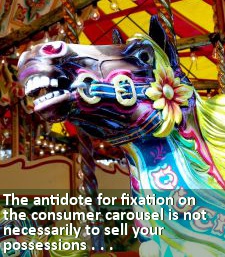Thinking Wrongly About Money
Discussion
The Aspirations and Illusions of Wealth
 Reprinted with permission from Paraklesis, Fall 2011.
Reprinted with permission from Paraklesis, Fall 2011.
“What am I going to do now?” Challenges arising from our current economic crisis such as unemployment, under-employment or such crises as the death and disability of loved-one, rebellious children, or a prodigal spouse raise this challenging question in pastoral ministry. At times, however, this question arises from the opposite extreme—that of unexpected wealth. Sudden abundance of natural resources (such as the Marcellus Shale natural gas revenue in the Northeastern states), occasional estate settlements and business transactions also raise this question.
True worth
The Scriptures provide a number of principles regarding the illusions and influences of wealth. First and foremost is the principle that our intrinsic value and worth lies in our being image bearers of God (Gen. 1:26). We do not look to a percentage of assets to establish worth. As someone has said, we are persons and not percentages!
James 1:27 and Deuteronomy 14:29 reinforce the biblical view that each person has intrinsic worth irrespective of status. In Genesis 1:26, Moses writes that we have “been created in His image.” God stamped His moral likeness in each person regardless of gender, ethnic background, physical appearance, intellectual capacity, wealth, status, etc. Humanity is defined in terms of being created in God’s image. If we were not created in God’s image, we would not be human. Intrinsic worth is derived from our Creator and not from wealth (Ps. 139:13-15).
Jesus taught that those who define themselves by their percentage or pursuit of worldly goods would be sorely disappointed (Matt. 6:25-34). He emphasized the dangers of being consumed by wealth as He told the parable of the rich businessman who built bigger and bigger barns to store all his crops. The parable ends with this man dying having not laid up any treasure for himself in heaven nor used his wealth to help others. Jesus concluded by emphasizing the need to be rich toward God (Luke 12:13-21).
Discussion
“How about a million of your 50 million?”
Body
Discussion
New Jersey Church Distributes $30,000 in "Reverse Offering"
Body
Discussion
"The immediate cash-flow crisis has passed, but the long-term solvency crisis remains."
Body
Discussion
Book Review - Health, Wealth & Happiness: Has the Prosperity Gospel Overshadowed the Gospel of Christ?
[amazon 9780825429309 thumbnail]
Being unsure if he would ever see them again, Paul called together the elders of the church at Ephesus (Acts 20:17-38). He reminded them of their duty to protect God’s flock. He told them to be on guard because he knew savage wolves would eventually try to feed off the flock. These wolves in sheep’s clothing, with their perverse gospel, would seek to gather as many sheep around them as they could. Paul doesn’t say exactly what this perverse gospel would be, but perhaps he had it in mind as he concluded his words to the elders. “I have coveted no one’s silver or gold or clothes.” He then left them with the words of the Lord Jesus, “It is more blessed to give than to receive.”
Some years later, Paul sent Timothy to Ephesus to combat these wolves that Paul had warned of. Prominent among the false teaching being used to fleece the sheep was “that godliness is a means of gain” (1 Tim. 6:5). These depraved men, deprived of the truth, had discovered a way to make money off ministry. By practicing what they preached, they were getting rich off Jesus. This prosperity teaching however was ruining people’s faith (1 Tim. 6:9-10).
Today’s church is also confronted with this perverse gospel. Ironically, while claiming to encourage faith, the “Prosperity Gospel” actually destroys people’s faith by substituting faith in the real gospel with faith in faith. As David Jones and Russell Woodbridge point out in Health, Wealth & Happiness, the prosperity gospel’s roots are found in the “New Thought” movement of the early twentieth century. “In the New Thought works, one can discern some of the key recurring elements of the prosperity gospel: speaking the right words, invoking a universal law of success with words, and having faith in oneself” (p. 31).
Jones and Woodbridge have PhDs from and teach at Southeastern Baptist Theological Seminary. They are both uniquely qualified in the areas of finance and Christianity. They have produced a very informative and readable critique of the prosperity movement within evangelicalism.
The book’s six chapters are grouped under two headings. Chapters one through three offer a critique of the prosperity gospel and prosperity preachers. Chapters four through six offer a correction of the false teaching of prosperity. Chapter one excavates the foundations of the prosperity gospel as being built upon “New Thought Philosophy.” In chapter two one can readily see the link between this philosophy and the unorthodoxy of the prosperity message. They conclude, “while many prosperity teachers offer the plan of salvation, they undermine the gospel with their teaching” (p. 71). Jones and Woodbridge use Joel Osteen as an example. “While Osteen certainly appears genuine and sincere in his faith, his prosperity message is anything but harmless” (p. 73). They go on to demonstrate how Osteen “misinterprets Scripture, misunderstands the gospel, and lacks theological conviction” (p. 73). Chapter three exposes the errors of prosperity theology by examining how it perverts Scripture’s teaching on: the gospel, faith, atonement, the Abrahamic Covenant, the mind, prayer, the Bible, and giving.
Discussion
Life Beyond the Consumer Carousel
 If you are a typical, suburban American, you ride a wooden horse on the “consumer carousel.” And on this economic joy-ride, there is a place where we grip the pole with our left hand and reach out with our right to grasp a brass ring. Then, as our painted horse proceeds in a lazy circle to the accompaniment of festive music, we get another chance to grab another ring. And on this particular ride, the rings get bigger and better with each pass.
If you are a typical, suburban American, you ride a wooden horse on the “consumer carousel.” And on this economic joy-ride, there is a place where we grip the pole with our left hand and reach out with our right to grasp a brass ring. Then, as our painted horse proceeds in a lazy circle to the accompaniment of festive music, we get another chance to grab another ring. And on this particular ride, the rings get bigger and better with each pass.
On our first circuit we sign a lease on a modest apartment. The carousel slowly turns and with great excitement we return to the ring post and hook a starter home. On the next pass, we hope to grasp a bigger house in a better location.
On round one we dine at McDonalds and Dairy Queen. But as the carousel completes another revolution, we upgrade to Red Lobster and Olive Garden. On the next round we reach for a yet bigger and better brass ring, hoping to dine at exclusive restaurants with story-book names, opulent décor and white-capped chefs.
On our first pass we secure a used car. On the next round we get something “more reliable.” Another pass or two and we are reaching for that car or truck (or tank) of our dreams.
Life on the consumer carousel is all about upgrading. Each circuitous pass provides fresh opportunity to secure a bigger and/or better replacement of what we already have. Bigger and better shelter, higher quality food, more expensive clothes, better transportation, entertainment, appliances, furnishings, vacations, and on and on it goes.
Economic conditions among suburbanites in this country vary considerably. But we all have a horse on this ride. Admit it, there is something right now that you are hoping to replace with something more costly in the near future.

Discussion